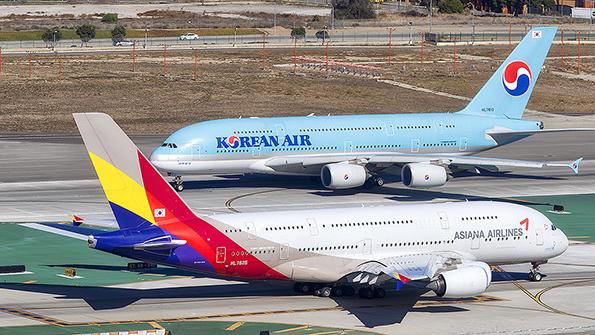
Korean Air’s plan to take over rival Asiana Airlines will not only increase its strength in the important South Korean market, but also vault it into the top tier of global carriers by size.
The purchase is seen by the government and Asiana’s creditors as the best way to ensure the continuation of Asiana’s operations. The airline was struggling even before COVID-19 emerged, and the pandemic drove it to its knees. Merging the two airlines will reduce competition, but very few alternative paths appear to be available to retain Asiana as a viable competitor and prevent mass job losses.
Korean Air said on Nov. 16 that its board has agreed to buy a majority stake in Asiana for 1.8 trillion Korean won ($1.6 billion). State-owned Korea Development Bank (KDB) is investing 800 billion won to support the deal, and Korean Air will issue new shares next year to raise 2.5 trillion won, which will fund the acquisition.
Korean’s CEO Walter Cho has stressed that protecting employee job security will be a priority. However, questions regarding how much of Asiana’s fleet and network will be retained are yet to be determined. There will be some degree of overlap, but the deal will still potentially increase Korean Air’s size dramatically.
The airline highlighted this point by saying it expects to be ranked as one of the top 10 airlines in the world once the acquisition is completed. The resulting expansion of its routes, fleet and capacity will give the airline better ability “to compete with global mega-airlines,” Korean Air says. The fact that South Korea has two large full-service carriers means a “competitive disadvantage” compared with countries such as Germany, France and Singapore, which have a single major airline.
Korean Air was ranked 18th in terms of international passenger volume in 2019, and Asiana was 32nd, according to statistics from the International Air Transport Association. Their combined total would have ranked 10th globally and first for Asia-Pacific airlines. In terms of revenue passenger kilometers, the pair would rank 11th overall.
Both carriers are particularly strong in cargo, and the merger will amplify their position. Korean ranks fifth globally in terms of international scheduled cargo ton-kilometers, and Asiana 23rd. When added together, they would be third on the list, behind only Qatar Airways and Emirates.
The acquisition deal will expand Korean Air’s already leading share of the South Korean market. And by enhancing the airline’s network and adding to connecting opportunities, the merger will strengthen the standing of Seoul Incheon International Airport as an Asian hub, Korean Air says.
For the week of Dec. 2, 2019, Korean Air accounted for 22.4% of the international seats in the South Korean market, according to data from CAPA – Centre for Aviation and OAG. Asiana was second with a 15.4% share. Together, Korean Air and Asiana would have provided 37.8% of seats in this market, or 48.1% when including their low-cost carrier (LCC) subsidiaries.
At Incheon, Korean’s 25.3% share of seats and Asiana’s 17.9% share of seats would have combined for 43.2% for the week of Dec. 2 and about 50% with their LCCs. This level of group dominance occurs at some other large airline hubs; Cathay Pacific, the SIA Group and the Lufthansa Group are among those with a similar or higher share at their main bases, CAPA data indicates.
Korean, Asiana and their subsidiaries hold a combined 67% share of seats in the Seoul-Jeju market, which is South Korea’s most important domestic route and also the world’s busiest domestic route.
Consolidation of some kind in the crowded South Korean market has appeared likely for some time, and the latest crisis made it more pressing. “Korea’s aviation market was oversaturated even before the pandemic, and we have growing concerns [regarding] the industry’s uncertainty post COVID-19,” says Korean Air President Kee Hong Woo.
Acquiring Asiana “will give us a strong competitive edge,” Woo says. “After integration, we will be able to operate our fleets, routes and schedules more flexibly and efficiently. We can also maximize synergies by sharing both airlines’ infrastructure, such as cargo terminals, flight training centers and maintenance facilities.”
Combining the fleets will bring challenges. Korean Air has a mainline passenger and cargo fleet of about 170 aircraft, including more than 30 stored, according to the Aviation Week Network Fleet Discovery database. Asiana has a fleet of 75, with seven in storage.
The pair operate some passenger types in common, including Airbus A380s and A330s as well as Boeing 777s and 747 freighters. They use different narrowbody models: Korean Air mainly relies on 737s, and Asiana uses A320/A321s. Korean Air has 737 MAXs on order, but it has also recently added 10 A220s, and both carriers have ordered A321neos.
A major point of difference is that Korean Air is refreshing its widebody fleet with Boeing 787s, while Asiana has turned to A350s. Korean already has 10 787-9s in service, and 10 -9s and 20 -10s are on order. Asiana has 11 A350-900s in its fleet, with another 10 -900s and nine -1000s on order.
The enlarged Korean Air would have an even more diverse fleet. However, the airline has already proved it is willing to operate similar types from both manufacturers after buying A380s and 747-8s in addition to Boeing MAXs and Airbus Neos.
Another notable aspect of the merger is that Korean Air is taking on a financially troubled and heavily indebted company. This would be a difficult enough prospect at any time, but Korean will be coping with the assimilation at the same time as it attempts to recover from the coronavirus-related downturn.
Asiana was under financial pressure before the pandemic hit. Its parent Kumho Group had agreed to sell its controlling stake in Asiana to Hyundai Development Corp. (HDC), but the deal collapsed in September, after airline values declined due to the COVID-19 crisis. This effectively put Asiana under the control of KDB and other creditors.
The new acquisition deal is expected to close during 2021, Korean Air says. Approval from various governments will be required, and that may take some time. Another hurdle is a court challenge from an activist investor group that is a major shareholder in Korean Air’s parent Hanjin KAL.
Korean Air tells Aviation Week that initially Asiana would operate as a subsidiary of Korean Air. Ultimately, the Asiana brand would disappear, “but the process would take years,” an airline spokesperson says. Whether Asiana stays in the Star Alliance will be discussed during the acquisition process. Korean Air is a member of SkyTeam.
Asiana’s LCC subsidiary Air Seoul and its controlling stake in Air Busan will be included in the deal. However, whether the LCC subsidiaries would be retained or merged with Korean Air LCC subsidiary Jin Air is still to be decided.
Under the acquisition agreement, KDB will invest 800 billion won in Hanjin KAL, which will immediately loan that amount to Korean Air. Korean will use 300 billion won to acquire perpetual convertible bonds from Asiana. Another 300 billion won will be used as a down payment on the Asiana acquisition price.
Together, these investments will provide Asiana the funding needed for its operations until the end of the year and improve its financial position.
Hanjin KAL says it chose to receive the KDB funding by issuing new shares rather than borrowing from the bank in order to “maintain a stable financial structure.” KDB’s shares will give it voting rights, and the bank will “monitor and make sure Hanjin KAL and Korean Air follow through with the acquisition plan,” Korean Air says.

